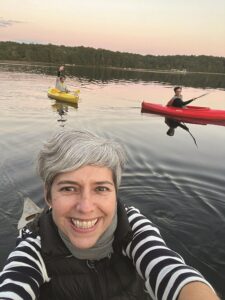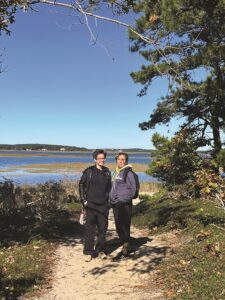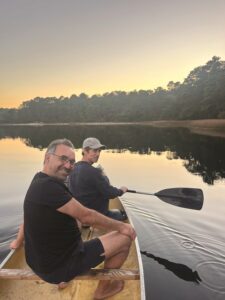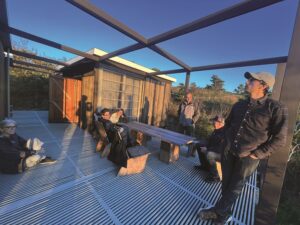WELLFLEET — When five Mexican and Mexican-American poets, artists, and architects arrived at the modernist houses that dot the seashores and backwoods here in early October, they had “the best kind of house envy,” says Gabriela Jauregui, a poet and novelist from Mexico City. She was here as part of an artist residency hosted by the Cape Cod Modern House Trust (CCMHT).

When the poets arrived Oct. 9 for their week-long stay in the restored Kugel/Gips and Kohlberg houses, they scurried from house to house, giddily exploring the architectural oddities of each structure. “We were like, ‘Oh my god, your house! No, your kitchen!’ ” Jauregui says.
She was joined by Alexander Provan, editor of the New York-based magazine Triply Canopy; the conceptual artist and poet Laureana Toledo of Mexico City; the architect and poet Juan Carlos Cano of Mexico City; and Mónica de la Torre, a Mexican poet and editor living in New York who curated this year’s program.
This was the 13th iteration of the CCMHT’s artist residency, which began in 2010 as a way of bringing groups of artists and thinkers to the modernist houses in Wellfleet for a week of collaboration and conviviality.

Although writing is a solitary ordeal, and poetry is perhaps its most solo manifestation, three of the poets were there to reignite a collaborative history that had been on pause for more than a decade. Jauregui, Toledo, and de la Torre, along with a fourth friend, Aura Estrada, published a book of collaborative experimental writing in 2011 titled Taller de Tacquimecanografía, or The Shorthand Typing Workshop in English. (Tacquimecanografía is a Spanish portmanteau coined by the writers that combines “stenography” with “typewriting” — “Even in Spanish, it is a difficult word,” says Jauregui).
Estrada pitched the project as a way for the four emerging writers to push through a male-dominated literary world, cemented by Latin-American literary movements led by prolific male writers like Gabriel García Marquez and Jorge Luis Borges.
“In Mexico, the literary world was a bunch of dudes publishing their dude friends and maybe one or two women who laughed at their jokes,” Jauregui says. The project, in which the four women wrote in all forms and the exchanged their pieces to be rewritten and expounded on, was “a way of rethinking authorship,” Jauregui says, during a time when the only form of written output produced by women was secretarial.

As they were completing their final rounds of text, Estrada was killed in a freak surfing accident on Mexico’s Pacific coast. Toledo, Jauregui, and de la Torre collated the material they had into a book to honor her. De la Torre curated this year’s residency to bring the three together — along with new minds — for the first time since they completed the project.
Here the writers had time to work on their individual projects, too. Jauregui is working on a novel about a woman who goes to live alone in the Mexican countryside, along the “tenuous border between civilization and wildness,” she says. Where Jauregui lives in San Mateo Acatitlán, a rural town an hour outside Mexico City, tensions exist along that border — developers are beginning to clear forests to build suburban gated communities, dispossessing indigenous communities that have stewarded the land there for millennia.
Juan Carlos Cano spent the Wellfleet week working on poetry that pooled his technical expertise in architecture with anecdotes based on what he found inside the Kugel/Gips house, where he stayed. They included imagined moments from Kugel’s life and the shipwrecks that long ago flecked the Cape’s shores. He says he doesn’t like to make poetry out of architecture or architecture out of poetry — “I find it very corny,” he says — but his “architect thinking” informs the structural layout of his poetry.

And, Cano admits, there can be poetry found in some architecture. Útopias, a series of municipal projects designed to bring free social and artistic programming and public utilities to marginalized neighborhoods of Mexico City, is one such example. In a neighborhood called Iztapalapa, one of the neighborhoods, Cano is working on a wastewater treatment facility that includes building a wetland over a 20-acre landfill. “I guess if you have debris, and you turn it into a wetland, that’s poetic in a way,” he says.
Mónica de la Torre is studying the Mexican architect Luis Barragán, who designed a residential subdivision in Mexico City in 1945 where a cluster of modernist houses was built above a calcified milleniums-old lava field. Those homes have since been demolished, de la Torre says, and the neighborhood has been parceled into Tudor houses for the wealthy.
“The experience is now completely different from what the original architects had envisioned,” de la Torre says. She is channeling this “failed architectural utopia” into a prose piece that weaves her research together with narrative constellations of the people associated with the project.

Jenny Monick, president of CCMHT’s board of directors, saw a throughline between de la Torre’s work and the work of Peter McMahon, the trust’s founder. She asked de la Torre to curate this year’s residency.
McMahon, an architect himself, founded the Cape Cod Modern House Trust in 2007 to preserve historically important architectural landmarks in the Cape Cod National Seashore. Now, the trust is at an inflection point — McMahon is working with Marcel Breuer’s son, Tamás, to buy the Breuer house on Williams Pond before it goes on the open market, where it is at risk of being demolished due to its advanced state of disrepair.

McMahon has been raising money to purchase the house. He says that so far he has raised $750,000 of his $1.4 million goal. (An article published in the New York Times in August helped, McMahon says.) If the deal goes through, it will be the trust’s “flagship” house, McMahon says. He hopes to use it to host a four-month residency for scholars of Breuer and the Bauhaus, who would have access to Breuer’s archives here.
Bringing artists from all over the world to enjoy and convene in Wellfleet’s touchstones of modern architecture is, McMahon says, “like bringing salt water back into the East Harbor” — it is about breathing life back into a nearly forgotten ecosystem.
